Hardwax Oil Experiment – Part 1 OSMO Polyx Oil [2024 UPDATE]
At Tadas Wood Flooring we’re constantly looking for and testing new finish systems so we can guarantee the best coatings for our client’s floors. Over the next few months we’ll be testing several these new hardwax oil (or hardened oil) finishes that have entered market here in the States. For this post we’re going to dive right in to our first hardwax oil test subject – OSMO Polyx 2K Oil…
[See below for our OSMO Polyx Oil 2K 2024 update.]
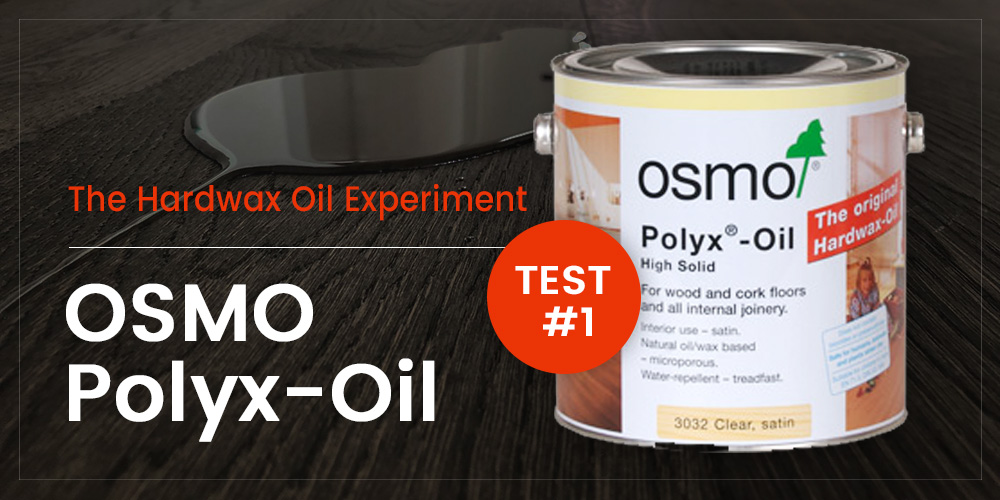
The OSMO Polyx Oil finish system comes from Germany where it’s been in use for many, many years. It’s only recently gained steam over on this side of the pond though. We’ve used it about 10 times during the last few months so we’ve had a pretty good test run with it.
Here’s a rundown of features and benefits from the OSMO marketing material:
OSMO Polyx-Oil Features:
- The finish is blended from natural plant oils and waxes
- Once cured it’s highly water resistant
- It is very environmentally friendly with low VOC’s (Volatile Organic Compounds)
- Doesn’t stink up and drive you out of your home like some finishes will
- Doesn’t form a plastic film like other varnish, acrylic and polyurethane finishes
- It’s easy to look after and maintain
OSMO Polyx-Oil Benefits:
- Safe to use and have in your home with environmentally friendly ingredients
- It’s approved safe for bench tops, food preparation areas and children’s toys
- It won’t off-gas bad fumes, chemicals and smells for weeks after it’s applied
- Can be used in domestic as well as commercial applications
- Enhances the beauty of your timber’s natural grain
- It binds to wood grain and will not flake, blister or peel
- Damage can easily be spot repaired
That’s a pretty impressive list of claims. When we first started using this finish last year we wanted to see if it really was as good as they say so we began our tests…
STEP 1 to our OSMO Polyx-Oil Review:
First we experimented in our workshop on sample boards for a few days. We always do this for any new product we experiment with. If it doesn’t pass the workshop test then there’s no use wasting time and potentially ruining a good floor.
After some testing and messing about we had our first sample boards done. The application was quite easy and the durability seemed pretty impressive as it endured all sorts of abuse in our attempts to scratch and damage it. Dry time was adequate, VOC’s were very low and the smell was nothing compared to an oil based finish. Step one passed, onto the next stage…
STEP 2:
The next step was to find a floor to test it out on in the real world. In stepped our good friend Arvydas from Arch Remodeling (you can see some of our other projects with him on our Photo’s page). Arvydas is an amazing contractor and is always willing to try new products and systems like us to better his game. He also had the perfect floor in Orland Park, Illinois – beautiful random width French white oak – that was ready to refinish so it was a perfect match!
This was the first real life subject of our “Hardwax Oil Experiment”…
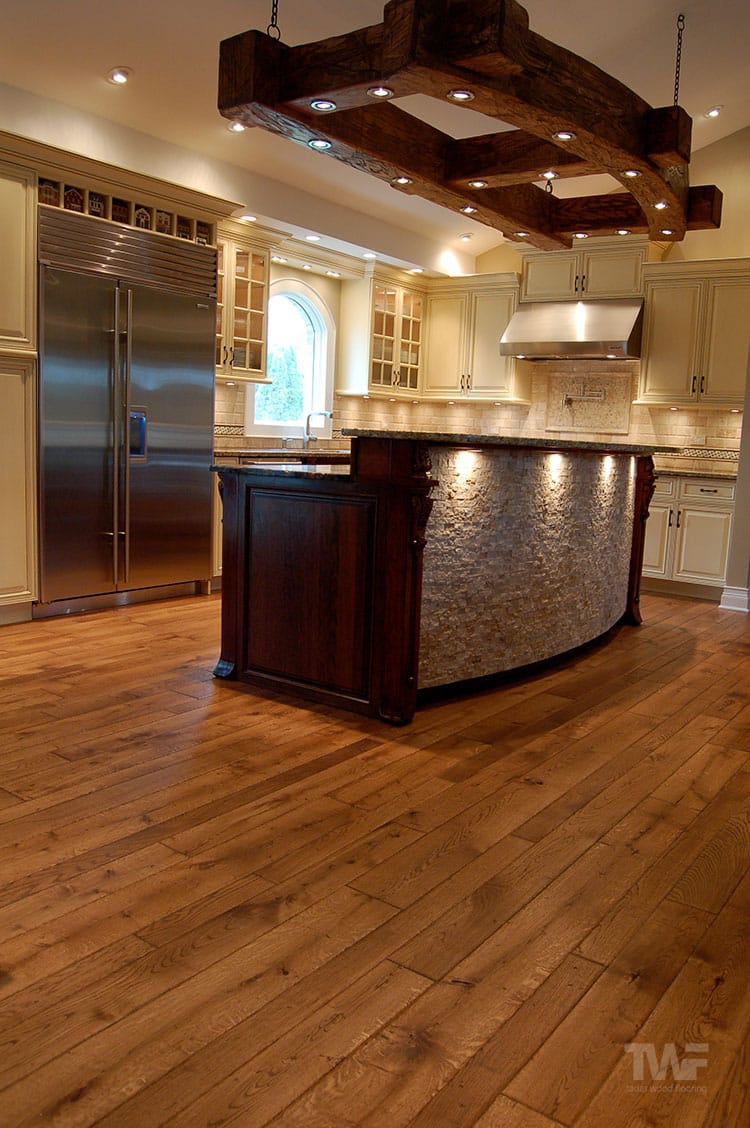
We think the natural hardwax oil finish looks great over the Golden Brown stain…
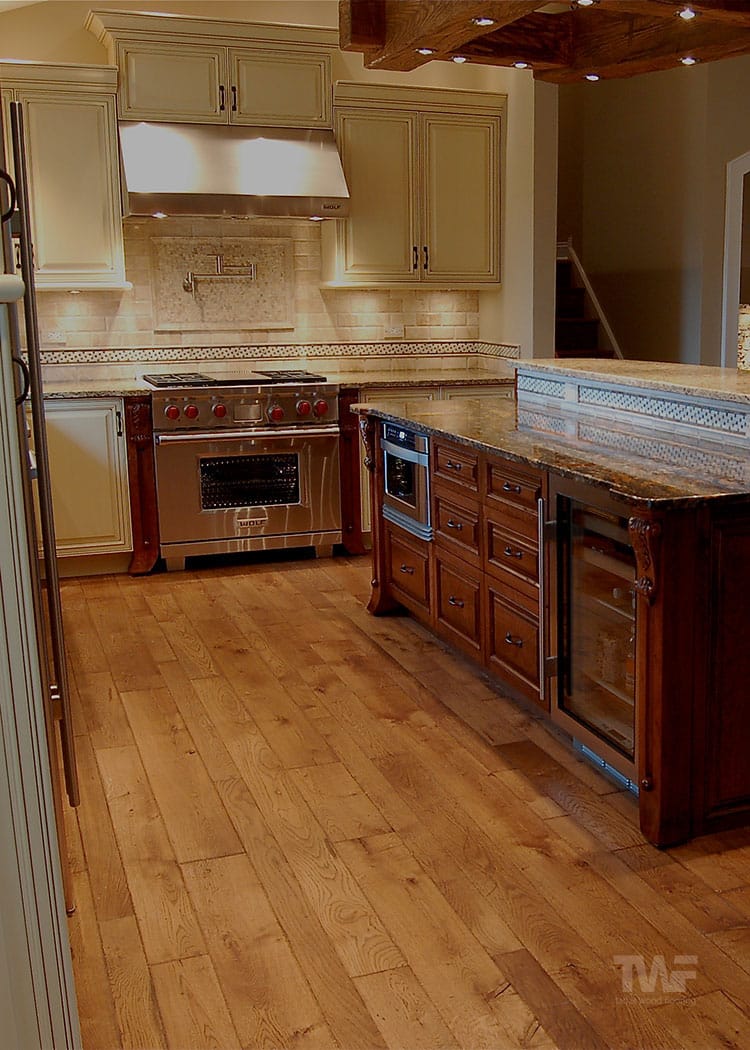
After this job turned out so well we were eager to try it again. Our chance came a few weeks later with another hardwood floor in Glen Ellyn, Illinois. The project was a kitchen that the homeowner wanted to be able to be able to easily maintain if it got scratched and abused.
This time we stained the floors 50 percent Ebony and then coated them with OSMO Polyx Hardwax Oil. You can see the results in the pictures below…
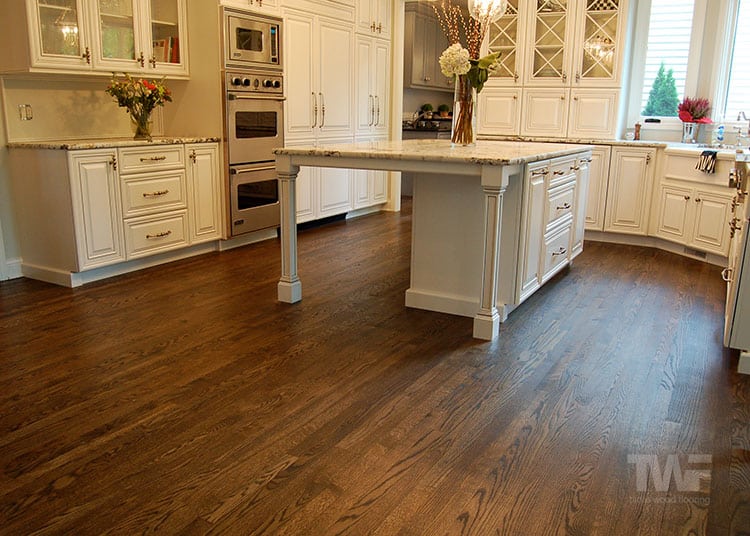
Here’s a photo from the other direction…
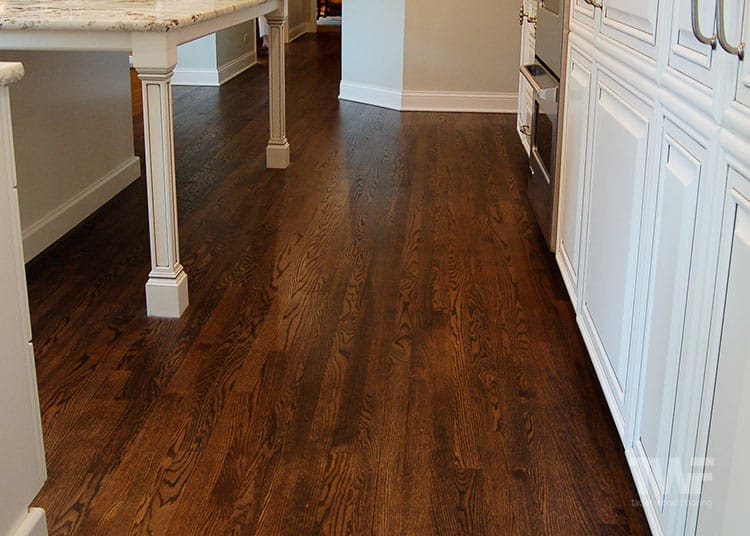
Arvydas (Arch Remodeling) was so impressed with the first OSMO project we did for him that he called us in again a few months later to use it again.
His latest project was a remodel of a basement in Orland Park, IL. The goal was to turn it into a very cool wine cellar and a cool and trendy downstairs getaway/retreat for the client to relax in. It would feature a bar, a comfy seating area with a big screen flat panel TV and surround sound system, a cozy fireplace, a wine room complete with a top-end stainless steel wine cooler and pretty much everything else you could want for the perfect chill out spot.
Since there was no wine available yet, our interests soon turned to the beautiful Mesquite end grain flooring he had recently installed. You can see a picture of the finished product below to see how beautiful the Mesquite flooring looks and how the project turned out.
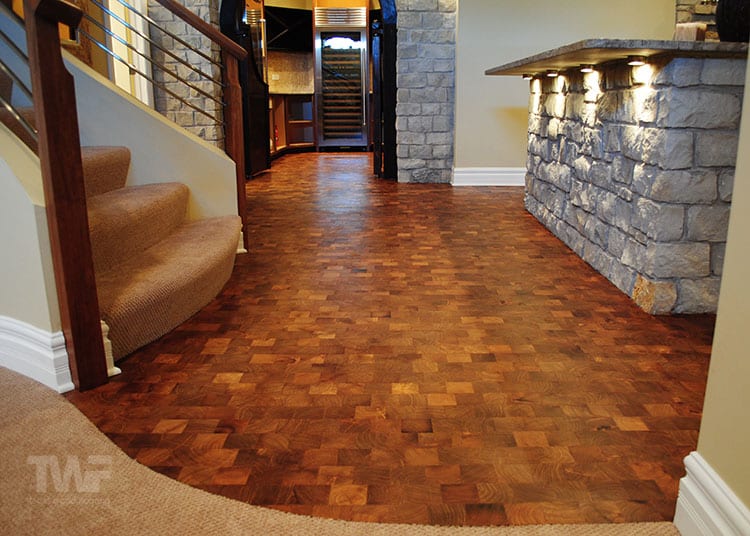
So what are our impressions of this finish system?
Well let’s go back to the basics of what we look for in a finish:
- Has to look good
- Be long-lasting, durable to traffic and resistant to spills
- Have relative easy maintenance and repair
- Not “yellow” excessively over time
- Not have high VOC’s and stink up the home for days on end
- Not take forever to cure
That’s a pretty tall order, but one we won’t compromise on. So far we’ve only found a few finishes that stand up to these requirements. Let’s go through each of these one-by-one below to see how OSMO faired…
1. Good Looking:
This one was easy to judge. From the pictures above and the one below what would you say? We think it looks great! We love how it brings out the natural beauty of the wood without covering it in a layer of “plastic” like so many other finishes do.
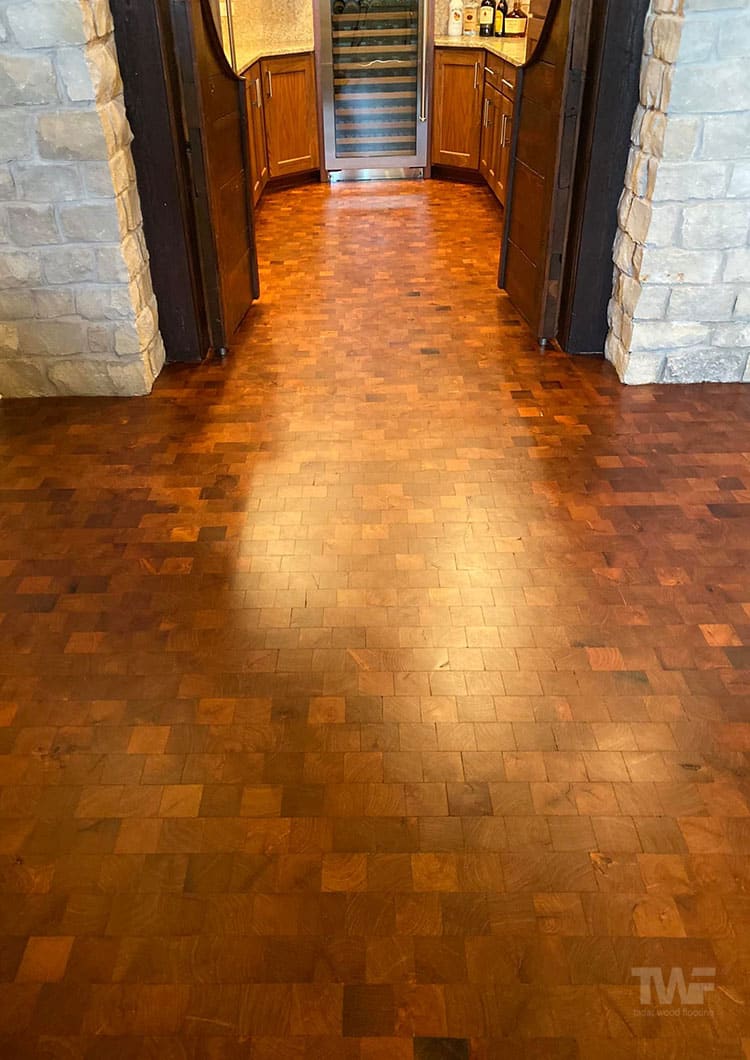
There is a small selection of oil colors available, but you can use stain under the oil as well if you would like something more unique. And you have a choice of satin or matte sheens.
2. Long-lasting, durable to traffic and resistant to spills:
This is obviously a big issue with floor coatings. Who wants a beautiful finish only to realize it is useless to daily wear and occasional mishaps and spills. Or, it looks great and is durable for a while, but then quickly wears down after a few months or years.
This is the case with many cheap oil based and single component water based finishes out there. Once the inadequate coating wears down on a cheap finish it starts to blister, peel, crack and flake, leaving the floor susceptible to damage. When liquids and dirt get into these cracks they do damage to the wood underneath. That’s why you see patchy grey areas on old floors (or not-so-old floors with cheap finish).
Traditional penetrating oil systems look great and are resistant to traffic and spills to a point as well, but they’re definitely not long-lasting. They need constant upkeep and re-coating to keep their protection intact which can be a nuisance to many homeowners.
With OSMO you get the best of both worlds – the beautiful look of a traditional oil finish and the durability of a higher end “plastic” finish. As it’s applied, the oils in the finish penetrate deeply into the wood pores to protect it from the inside and the wax in the finish stays on the surface leaving a protective layer that offers a water resistant and lasting finish. No matter what is done to it, it doesn’t watermark and it won’t crack, flake, peel, blister or panelize like conventional finishes.
We (and many others before us) have tested this finish with boiling water, wine, soft drinks and other liquids that are commonly spilt in a home as well as dust, foot traffic and scratches. It stands up commendably. For any small imperfections in the finish a quick polish with the Osmo Liquid Wax Cleaner is all that is needed and the surface looks as good as new again.
Is it as strong as our Pallmann water-based finish systems?
No.
But… and this is a big but… the great thing about OSMO Polyx Hardwax Oil is that if there is damage done it can very easily be spot repaired – which brings us to the next point…
3. Easy Maintenance and Repair:
Easy maintenance is one of the reasons “plastic” finishes are so popular and old world penetrating oil systems are not. With a plastic oil or water based coating, if a liquid is dropped on the surface, you just need to wipe it up and the disaster is averted. They are also easily cleaned with a damp mop or cloth, and a Swiffer type of broom or a soft bristled vacuum quickly takes care of dust in-between washes.
The strength of this system is also its greatest weakness though. Because these finishes are basically a big “plastic” sheet spread out across the entire floor once dried, when there is major damage like deep scratches, they are very hard to repair properly. I shouldn’t say they’re hard to repair really, I should say it’s extremely hard to blend in the repair with the rest of the floor.
The reason is because these type of finishes need to be abraded before the touch-up coating is applied and the touch-up coat never is the same sheen as the surrounding floor sheen so the repairs stand out like a sore thumb. We’ve even done repairs from the exact same bottle of finish and they come out a different sheen! The only way to seamlessly blend in a repair to a “plastic” finish is by buffing and re-coating the entire floor – which is obviously a big hassle and expense.
For us, this is where hardwax oils really shine.
Osmo Hardwax Oil produces a surface which will not watermark or stain like a traditional oil finish. It’s also very easy to clean – just sweep, vacuum or damp mop. Yes they’re not as damage resistant as a top-end 2 component water-based finish… but, when damage happens, the surface can be spot repaired and sanding of the whole area is not required (see our 2024 update below for proof).
This is a huge feature.
Basically the finish is formulated so that only the open wood fibers accept the finish. The new application of finish will not adhere to the existing finish next to the scratch. There are no overlaps of finish and the sheen blends in perfectly with the existing floor. If well looked after and properly maintained, this finish system will last a lifetime and you’ll never need to re-sand your floors ever again.
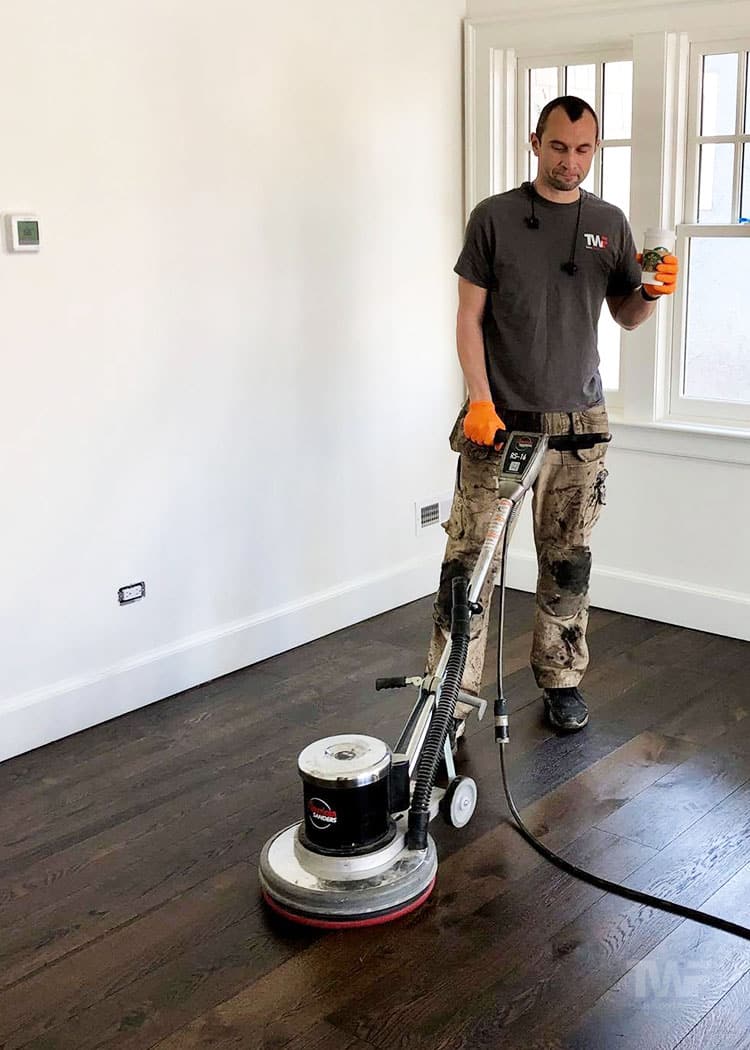
The one downside to this amazing feature – your floors will need to be top-coated every couple of years, like you see me doing in the picture above (while taking a coffee break).
But it really isn’t as big a deal as it sounds. It can easily be done by the homeowner (we can give detailed instructions and supply the product) or we can come out and do it within a few hours and your floor will be ready the next day. You also don’t have to move out your furniture as the worn out pathways are the only areas needing attention. It’s a lot easier than maintaining a traditional oil finish every couple of months and also way less hassle than completely re-sanding and refinishing your entire hardwood floors every 7 to 10 years if you have a lower-end “plastic” finish.
4. Non-Yellowing:
The vegetable oils used in the finish (which include Sunflower Oil, Thistle Oil and Carnauba Wax) are non-yellowing so you don’t have to worry about that ugly “old” look after a couple of years.
5. VOC and Stink Factor:
VOC is short for Volatile Organic Compounds. These can be harmful to the environment as well as for your health. Governments are trying to cut down on the usage of products with dangerous levels of VOC’s and have recently started regulating the hardwood floor industry. This is no concern to us as we’ve cared about our own health as well as our clients for a long time now when it comes to using unhealthy finishes.
Our current favorite finishes, Pall-X 96 and Pall-X 98 are 150g/liter and 250g/liter in the VOC department. That is extremely low for a high-end finish. Most oil based finishes are way above 500g/liter and Glitsa is way up there at 725g/liter. OSMO PolyX Pure Oil has less than 50g/liter. It’s very environmentally friendly as well as being safe for your family’s health so we have no problem at all using it. The smell is just a mild solvent smell that will dissipate quickly with proper ventilation.
6. Time to Cure:
There are 2 types of OSMO oil – the normal blend that takes 8 hours to dry and a quick-dry blend that is dry in 4 hours. As it’s a 2 coat system it equals the time of a 3 coat water-based system and is much faster than a 3 coat oil-based system. Nobody wants their floors out of commission for too long so it’s definitely a win in our books for client convenience.
So what do you think? Did it pass our test?
We think it did extremely well. To tell you the truth we were pleasantly surprised – we didn’t expect so much from this little German oil finish.
I know that was a lot to take in above so we put together the chart below to help you see the benefits easier…
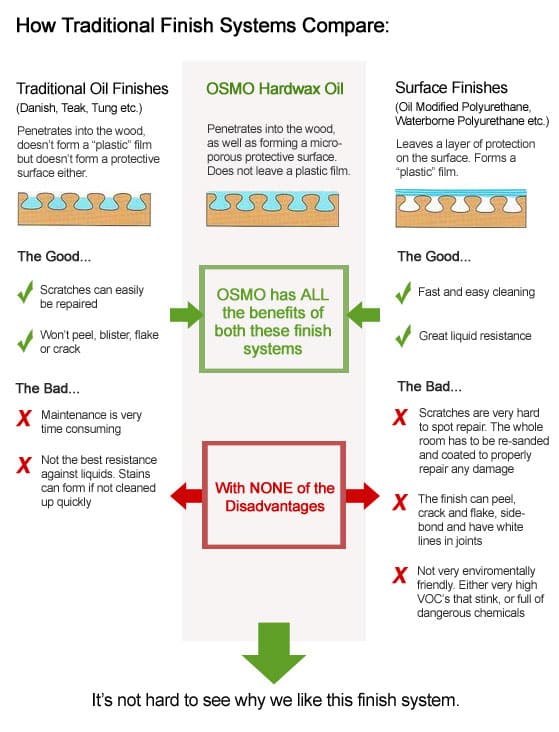
Our Conclusion…
We are very impressed with OSMO Polyx Hardwax Oil.
Over these last few months we’ve completely changed our minds about what we initially thought about these “new” hardwax oil products. (Good thing we like to experiment hey!)
In fact we’re so impressed by OSMO that very soon, after we have finished the full experiment with the other 3 products – Rubio Monocoat, Bona Indoor Oil and Pallmann Magic Oil – we will be integrating the best one of these coatings into our extremely hard to get into line of recommended finish systems. That’s great news for our future clients that want all the benefits that a high quality hardwax oil finish offers – natural wood look, easy spot repair, low VOC’s etc.
But even though we are very happy with the initial outcome of this experiment, we still feel that hardwax oil is not going to be for everyone. It definitely needs to be maintained and re-coated every so often which could be off-putting for a few people. It is also limited in the tints and colors you can have and you can’t get as shiny sheens if that’s your style.
These are issues that our Pallmann water-based finish systems don’t have a problem with. Yet on the other hand the Pallmann water-based finishes are harder to spot repair if you do happen to damage the very tough coating. So it basically your decision will come down to what you value more in a finish.
If you have any questions about either of these systems then we’ll be more than happy to discuss it over the phone or in person. If you book an In-Home Estimate with us then you’ll also get to see the samples we have of each finish system. One of them will be perfect for you and you floors we’re sure.
**2024 UPDATE: OSMO Polyx-Oil Review 11 Years On**
It’s hard to believe it’s been 11 years since writing this blog post. A LOT has changed in the flooring industry during that time. Thankfully, our view of OSMO Polyx Oil hasn’t. After using this hardwax oil on dozens and dozens of projects throughout the Naperville and Chicago area, we still love this finish and fully endorse it. It has definitely stood up to the test of time.
Below is a project we did with OSMO in Naperville in 2012, just after writing this post. After 8 years of wear, it was looking a little tired in the high traffic areas. You can see the wear in the photo here…
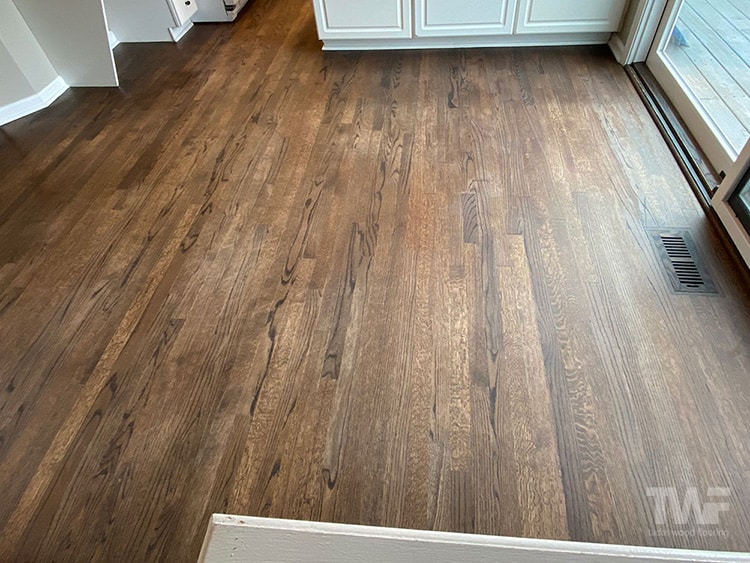
In May 2020, we went back to refresh this floor for the owners. This is the result…
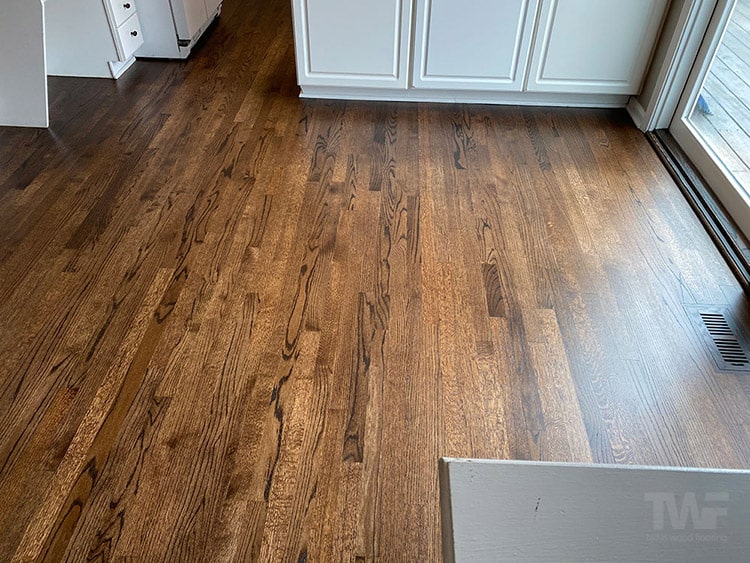
Like brand new floors!
No re-sanding. No re-staining. Just a good professional clean and a new coat of OSMO Polyx Oil buffed in. Pretty impressive right.
This is why we love hardwax oil finishes.
If you’re considering a hardwax oil finish for your own place, we strongly suggest giving OSMO Polyx Oil and it’s impressive track record some consideration. We’re definitely sold on it.
(Continue to Part 2 of our hardwax oil experiment featuring Rubio Monocoat)
–
Updated April 2024

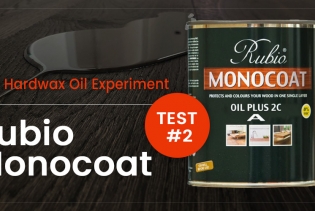
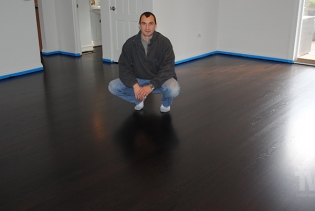
We are considering one of these 2 finishes for our floors. The guy that is helping us install says that sometimes these oil finishes actually take longer to dry in a very dry climate such as our here in SW Colorado (high desert, 7000 feet). Do you know if this is the case?
Hi Silvia and John,
Unfortunately I’m not 100% sure on this (although I’m pretty sure what the answer is) because we’re in a pretty humid climate here in Chicago :)
I would suggest trying out some on a sample board to see in person for yourselves (this is something any professional floor refinisher should do for their clients anyways). Even if it does take a bit longer to dry it’s not going to add a HUGE amount of time to the project time. I’m curious to see what you find out so please let us know if you have a chance to come back and reply.
And good luck with your floors!
Tadas
Hi Tadas,
Thanks for writing this up. I am considering installing site-finished hardwood floors myself and your site has been very helpful.
My wife requires a darker finish, so I am leaning towards the Osmo over the Rubio Monocoat, seeing as you can apply their Pro Color oil stain and then the 2 coats of Polyx-oil.
With the Osmo finish would you “water-pop” before you apply the stain?
Hi Josh,
You’re welcome, glad to be of some help. To answer your question… yes I would water pop first, especially if you want a darker color.
Good luck with your floors!
Tadas
I have been researching what to use on my pine floors which have recently been sanded in a Georgian house in Taunton, Somerset, UK. Having read your article, I found it really useful and the picture you have of the kitchen floor in Illinois is exactly the look I am trying to achieve. You state that you used Ebony stain 50% – was this the Osmo Wood Wax Finish, and what do you mean by 50% – was it one coat of the stain followed by one coat of the Polyx?
Hi Karen,
The mix was 50% Ebony and 50% Neutral stain. The brand we used was Dura Seal (not sure if you have that over in the UK). We then applied 2 coats of OSMO.
You’ll have to test on your floors though because the color will turn out a lot different on pine compared to the oak.
Good luck Karen.
How many years of high use can we expect before having to recoat with the Osmo, and if it is necessary, does the whole floor need recoating, or just the high traffic areas?
Hi Nicola,
If you look after your floors well with the right OSMO products you should get decades out of them before having to do anything major, and even then that would only be if there is damage to the actual wood you want fixed, not the finish.
Even with damage to the wood, you don’t need to remove all of the existing hardwax oil and recoat the entire floor. It’s possible to sand and repair select areas and then blend the old oil in with the new to have a seamless repair.
For small scuffs in high traffic areas use Liquid Wax Cleaner according to the instructions and you’ll be good to go. If you consistently look after any minor repairs needed, the finish should last indefinitely.
Hope that helps.
Tadas
We’re looking to install character grade walnut in our bedroom. I was getting conflicting answers about the no-VOC/low-VOC regarding OSMO. One installer told me that it has more VOCs than a waterbased finish…. I called the company directly and they claim their Polyx Professional is NO VOC(although not advertised on the site) and the original has some solvent mixed in it (used for brushing). I’m still confused because most places I look say that it is LOW VOC while curing and not NO VOC like Rubio claims. Rubio sounds like a good choice, although I’m not crazy about a pure matte finish.
Also, how does OSMO take to Walnut? The Osmo rep said that it is more porous and wood filler would need to be used in some places. What does it look like?
thanks for the write up on these oil finishes. It’s hard to get all the information!
Hi Sharon,
You’re welcome. Yes OSMO is a low VOC product, it has 50g/liter. To answer your question, we haven’t used OSMO on walnut to date. I’m sure it would look great though. Best to get a sample of each and test it out for yourself, then you’ll know for sure :)
Good luck Sharon, I hope it works out for you.
Tadas
Hi there, great test! I have pine floorboards and was planning on using OSMO WOOD WAX FINISH Transparent antique Oak 3168, followed by a coat of POLYX®-OIL ORIGINAL clear Matt 3062. Have you had any experience of using the transparent colour range and where the results any good?
Thanks Simon
Hi Simon,
Unfortunately we haven’t used the Transparent colors yet so we can’t help you there sorry. OSMO is a good finish though so I have no doubts the results would be good. Always best to test and experiment though :)
Good luck!
Tadas
Hi Tadas, I am in awe of your knowledge. Thank you for sharing. Could I be so bold as to ask for your advice?
My husband installed 1500 sq ft of yellow pine tongue and groove with gaps up to 1/8″. I sanded the ends and sides to give them an uneven beveled look. We are going for the rustic look with European flavor. I bleached them twice to rid them of any yellow color. I stained them with a mixture of 4:1 mineral spirits and Dura Seal Chestnut stain. I then white washed them with a 30:1 water and water based paint mixture. Just enough to give it a hazy look. I am very happy with the outcome. I want to use a HWO so that there is little sheen and no plastic look. However, I am scared the HWO will amber the floors. I know you think highly of Pallman Magic Oil, but the fellow at the supply store told me i had to go with X98 or X96 because the magic oil would amber the floors.
I checked with the Ciranova rep and he said Ciranova Magic Oil would not amber or yellow at all. ???
I checked with the Monocoat rep and he said not to use their HWO (it would not bond because of what I have already done to the floors) but instead use their maintenance oil only.
I know I should not be swimming in these waters, it is only for experts. But I am already here and I have to get back to shore! Could you be so kind as to give me your advice? My goal is a natural no sheen finish with no ambering. Thank you kindly, Kim
Hi Kim,
Wow, that is a lot of processes to use on a floor. Yes a hardwax oil will amber the floors. And yes there will be bonding issues because the pores of the wood are all clogged up now.
As far as a “no sheen finish with no ambering” I would suggest Bona Naturale or Loba Supra Extra Matte. You will need to do extensive testing for adhesion and compatibility issues in a closet or corner first just to make sure it will work. Personally and professionally I would have to walk away from a job like this because of very likely bonding issues. But I hope it works out for you. Please let us know how it goes.
Good luck.
Tadas
We are getting 1000 square feet of wire brushed alpine grade ash flooring in new construction. We really want a “not plastic” finish and would like the hard wax oil look; want to focus on the beauty of the wood with a very matte finish, no stain needed (no yellowing desired). Would one of these hard wax oils work for us? I have read all your reviews of products and this Osmo Hardwax Oil might be the best? We so appreciate all you have done to compare these products. Wish you could do our floors (but we are in Idaho) Thank you
Hi Susan,
You’re welcome… happy to be of help. Based on what you have told me I think Rubio Monocoat Pure would be your best choice.
Road trip to Idaho??? … can’t right now sorry :)
Tadas
I am in the process of staining my soft pine stair treads with dark Jacobean + Ebony Minwax oil stain, really dark, like 3 coats.
I don’t want to deal with polyurethane, plus my home is older and I think an oil finish will look more appropriate.
Can I use the Osmo to finish these, or will there be an adhesion problem because the wood pores have been so deeply stained? And also, does the oil finish stop off-gassing from the stain?
I should also add that the pine treads are newly installed and have never had any kind of finishing – poly, shellac, or oil, etc applied. Just sanded prior to the minwax oil-based stain application. Someone on the Gardenweb website said that Minwax stain has sealer in it, and therefore Osmo/any oil finish won’t penetrate. But I know in your blog you’ve said you used many brands of stain prior to applying the Osmo.
Hi Kelly,
Yes I would be worried about adhesion issues with that much stain applied. We only ever apply one coat of stain before using OSMO for that very same reason. I would suggest wiping off any excess extremely well and leaving it to dry for at least a week. Then you could do some tests on one or two of the treads to see if it will work.
I hope it does work out for you Kelly – good luck.
Tadas
We have applied to newly sanded 100+ yr old yellow pine flooring a coat of 5416 OSMO Jatoba color oil and then two coats of 3054 OSMO Polyx Satin-Matte Hard Wax Oil. I am dismayed because the floor finish scratches quite easily. I can actually scratch it with light pressure with my figernail. This cannot be correct. I thought the finish would be more durable than this. If some one pushes their chair back from the dinning table the floor is scratched. Also the floor has had two days to dry and it seems still slightly sticky. Do you have any advice?
Hi Erik,
Sorry about your troubles. You’re right, that isn’t correct. Was this applied by a professional? It definitely sounds like too much oil has been left on the surface.
It needs to be a thin coat and then the excess buffed off very well. It is always better to apply too little than too much. You could try to buff it off now but you might have trouble after such a long time, most likely the floor will need to be re-sanded.
I suggest contacting OSMO North America for advice, they should be able to help.
Hope you can get it sorted.
Tadas
Hi,
I am thinking of having white oak pre sanded, rift and quartered installed in my kitchen,dining and living room. Which finish would you suggest to keep the most natural color with a matte finish? It has to be durable and easily retouched.
Hi Lin,
Sorry for the delay. Are you after a hardwax oil finish? All of them will amber the floor somewhat but give Rubio Monocoat Pure a test run and see how you like that.
Tadas
for furniture, would you recommend osmo or rubio mono coat?
Hi Marci,
Either of them would work. OSMO will have more sheen and build. Rubio Monocoat will be more matte with less build and also has a greater color palette.
Tadas
Hi. Really enjoyed reading your hardwood wax reviews. I wish you guys were in LA, so I could hire you for a renovation we’re beginning. Can you offer any advice on what stains work best with the osmo poly oil? I’m thinking of testing the process myself on some samples, to see whether I can pull this off on my own.
I bought a small can of the Cosmo, and plan to stain and seal it myself. Any tips on the process would be greatly appreciated. Thanks again, and keep up the awesome work!
Hi Bragi,
Thanks for the compliment :)
To answer your question, we use DuraSeal stain. Hope the project goes well for you.
Tadas
Tadas – we could use your advice. We just laid reclaimed fresh cut heart pine wide plank floor. We are looking for a golden pine color with a slight sheen finish. We tried pallman but it looked too unfinished and the red brown is too red. What osmo products would you recommend?
Tadas-
We have fresh cut heart pine wide plank floors. We’re interested in using osmo hard wax oil. We also think we’d like a golden color. Do we use the osmo wood wax stain or the osmo oil stain to start? Any tips?
Hi Claudia,
Your floors sound very nice! Yes OSMO would work well if you want a slight sheen.
As for the golden color, you can use any color stain underneath OSMO oil to get the exact shade you want. You don’t have to be the limited to just the OSMO color oil. The two top photos above we used DuraSeal stain.
Like always, we suggest getting a few sample boards together, mix up some stain colors and have fun experimenting first.
Good luck with your project.
Tadas
So thankful to come across some information about Polyx Oil – thank you! We are considering staining 90 year old white oak floors a walnut color and would love to use this to finish them. My concern is about UV penetration. The house has original windows, and the reason we are refinishing the floors is due to bleaching from UV exposure. We are working to get protection on the windows going forward, but how does the oil stand up to UV exposure?
Hi Ashley,
From our experience it’s not too bad. It won’t be as good as some high-end waterbased finishes with UV inhibitors built into them though. As you know its the wood that’s photosensitive, not so much the finish.
I would get the window film put on first before doing the floors. No use spending all that money and then having them bleach out again.
Good luck with the project Ashley.
Nice informative blog,.,i am glad to visit this post.I get very useful information about osmo polyx oils..Thank you and keep sharing such blogs.
Im installing 2000 sq feet of 5″ yellow pine. The customer wants an early american stain color and osmo oil. I thought that staining would defeat the purpose of the penetrating osmo. What is the best way to achieve the right look? Thanks for any advice.
Chris
Hi Chri,
Sorry for the wait, I missed your question. Yes you can use dura seal quick dry stain and apply OSMO on top of it. No problem. We do it all the time. Just make sure the stain has properly dried.
Tadas
Ok, I have the Osmo oil red oak floors and love them! But what do I clean them with? I am not happy with all the warnings on the label of the Osmo liquid wax cleaner. Does not seem like a safe or “green” product. Anything with Naphtha in it concerns me. Any advice? Thank you!
Hi JoAnn,
Use the Osmo Wash and Care product. Liquid wax cleaner is not designed for everyday maintenance.
Hope that helps.
Tadas
We have just moved into our newly constructed home and had the Osmo oil matte finish installed. We have wide plank white oak floors and they applied two coats. We did not stain the floors and love the color however they now seem to be dull in high traffic areas, some are “greasy” in spots, and my wife says their are water spots in the great room kitchen. This was our floor guys first experience with this at our recommendation. I have read that a 3rd coat may make a difference but now that we are moved in, I would have to do it in sections. I did purchase an Orick floor buffer to aid in keeping them looking good. Do you have any great wisdom for us. It’s frustrating to spend so much and not have my wife satisfied. :-) Thank you for your assistance.
Hi Myron,
Sorry to hear your floors are not performing as well as you hoped. From this side of the computer it sounds like there may be too much finish left on the floor. People don’t realize that all the excess finish needs to be buffed off really well with white pads. Maybe get him back to do this and then add another third coat, this time taking care to buff off well first and then again 20 minutes later with new pads. Hopefully that will take care of it. (It’s a shame that people are experimenting on other peoples floors instead of in the shop or on their own floors first.)
Tadas
We have a 100yr old Fir floor in our upstairs that has recently been sanded and we are looking for an oil finish that will not so much change the color as just pull out the grain contrast. We have cabinets that my husband built made out of fir he milled from old crossarms off power poles that we finished with a wood conditioner then water based clear coat varnish. I’m wondering if we could put the same conditioner on the floors upstairs then finish with a clear/natural coat of an oil like the Rubio or Osmo for a more matte finish than what we have on the cabinets.
Thanks!
Hi Nicole,
It will be pretty much impossible to match a water based look with an oil based finish. Definitely test what you wrote above on a small area to see if you can make it close to the look you are going for… but don’t expect it to look like the cabinets your husband did. Sounds like a matte water based 2 component finish might be the way to go to get the look you want as well as durability – just not the benefits of the hardwax oils.
Hope it works out for you Nicole.
Tadas
Hi Tadas
We have a new blackbutt floor and were tossing up between an OSMO water poly or hardwax oil in a matte, clear finish. We want a natural look and no yellowing? What would be our best option? How often is a general recoat required or is maintenance only required for the most part for the hardwax oil finish? I am confused as you mentioned no yellowing in OSMO test but have noted comments re yellowing with hardwax oil in comments.
Your advice would be appreciated as our guy uses OSMO products only.
Hi Annette,
If you don’t want the floors to have an amber tint to them, then you will want to go with a water based finish. It will dry crystal clear and be matte if you like.
When we mention “yellowing” we are referring to the process of it turning that ugly yellow color as it ages. Hardwax oils are still oil based so they will add an amber tint as they are applied, like all oil based finish systems. They won’t go on clear like water based finishes. But they won’t yellow over time like the old cheap oil based polyurethane finishes do.
Hope that helps :)
Tadas
Goal: Waterborne color with the desired durability of poly. Could this be done by sealing with waterborne finish and topping with a couple coats of poly? Proper application and curing times considered…
Your thoughts?
Hello,
I’m so glad I found this—very informative! Next summer I’ll be installing new floors into the old Vermont farmhouse I’m renovating. My girlfriend and I have decided on wide plan, face-nailed, eastern white pine which has been sustainably harvested in VT and cut/kiln dried at the mill across town. The only thing left to decide on is what finish to use.
A friend of mine had sealed their cabin floors in Waterlox and I personally feel that not only did it make their floors too glossy they also have a neon-yellow hue to them.
So far it seems like Osmo could deliver on what we’re looking for in terms of durability and maintenance. We want to avoid that cheap-plastic look you had mentioned, but we’re also trying to avoid a finish that will aggressively tint the floor yellow. We’re okay with a slight amber hue—we are aware that pine will yellow over time—but we want a finish that will stay close to the true color of the wood and only add a slight warmth.
What Osmo product would you suggest for what we’re after? Do you have any photo examples?
Thank you for your time,
Brad
Hi Brad,
I’d be interested to hear how you resolved the finish choice on the white pine – and if you were satisfied.
Best,
Alan
Hi Brad,
Unfortunately we don’t have a lot of pine here in Chicago so I’m not an expert on it and don’t have any photos sorry.
For what you have described though, I would look into OSMO or Pallmann Magic Oil. If you can get a sample tin of each and test it on your flooring, you’ll see first hand which one you like the best.
Tadas
Hi Tadas,
I like your Jacobean and ebony mix. I tried it on a piece of oak by using 50% of ebony and 50% of Jacobean. But it doesn’t come out the same colour as your picture, the colour is dark and it did not bring out the brown colour. I have read all you blog on your website and it seems the finishing and seal are very important. Should I try OSMO clear oil to finish it? Can you please advise?
Thank you very much,
Hi Christine,
It may be a different type or cut of oak. There’s red oak, white oak and then rift, plain and quarter sawn products. Each will take the color differently.
Yes you can finish it with OSMO if you like. It’s a very good hardwax oil finish system.
Tadas
Hi Tadas
I had a eucalypt overlay floor installed by professionals a couple of months ago with Osmo Polyx as the finish. It was very slippery when we moved in and the floor seems to scratch quite easily – e.g.toddler moving some plastic toys would leave small scratches and one of the legs of a small clothes rack dragged slightly on the floor left a scratch and some loose waxy substance. From your answers above it seems to me that too much has been left? Could this be even if the floor felt super smooth? How can we fix the scratching problem?
Thanks in advance!
Judy
Hi Judy,
Yes it sounds there is too much oil left on the floor. I would buff it off really well then apply another thin coat and make sure all excess oil is removed.
Hope you can get it sorted.
Tadas
I’ve been comparing Osmo to Monocoat to Magic Oil after deciding Tung oil would be too much drama and maintenance. I’m tending toward Osmo simply because the application instructions don’t require a buffer, and since I’m doing my house in sections I’d end up spending lots of money repeatedly renting a buffing machine. Osmo also seems to be considerably less expensive than the other two. The drawback is the lack of color options. I realize in your test examples you applied over stained wood, but Osmo says that doing so will make invisible repair of scratches, scuffs very difficult. I’ve actually considered mixing oil soluble aniline dye crystals into it at a careful ratio to maintain consistent color. I’m frankly surprised Osmo doesn’t offer at least a few basic color options. Do you take them at their word when they advise against application over stain?
Hi Butch,
We do it, but yes, they are right… it will make a repair more difficult.
Tadas
Hello Tadas,
2 questions:
1. I’ve heard that if I want to stain pine, I need to condition the wood first, otherwise the stain will become blotchy and not soak in evenly. Would the conditioning affect the bond to the Osmo Polyx oil? Do you have any recommendations?
2. My floor has a section of older pine (Maybe 90 years old?) and newer pine (40 years old?). The newer pine is much more yellow after sanding… it could be a different species. What is the best way to get my floor to not have 2 very obviously different sections? I have not tried any finishing yet, but I’m aiming for a nice warm, medium to dark color in the end.
Thank you!
Bethany
Can you use Osmo Polyx Oil on Iroko internal floors?
Hi Ryan,
We have never done this so I can’t say for sure sorry. Best to set up a couple of sample boards and do a few tests.
Tadas
Have had OSMO in a high traffic room[T&G oak] since 2007. Did not recoat. Cleaned 2x-3x per year with OSMO Cleaner. I buy OSMO at a dealer in Seattle WA. not Amazon. Dealer has OSMO products that Amazon doesn’t. So, nail polish and hair dye stains go straight through OSMO. OSMO Oil Wax cleaner and OSMO wash-clean didnt seem to do anything. Sanded it. Re waxed. I can still see it. Am thinking of re sanding due to color differences between high traffic area and lo traffic part of room. OSMO Intensive cleaner didnt seem to clean enough to even out color difference[dirt-foot traffic]. So, if refinishing I would probably not use OSMO in similar situation. My ignorance re: re coating didn’t help.
Rest of house. Fir floors done at same time. Sanded off old UV yellowed polyurethane finish? Lower traffic areas. Same maintenance. OSMO was right finish for this application. In 2006-7 nothing else on market with low VOC.
DM
Hi Dennis,
Sorry you’re having some issues. Nail polish remover is acetone and that will damage most surfaces unfortunately. To make the repair invisible, it needs to be sanded with the same grit sandpapers and sequence as the original refinish. If not, it will show either as darker of lighter. Maybe get in touch with whoever did them originally and ask what they did so you can replicate it.
Tadas
Hi, I recently purchased some bamboo plates to use as wall panels. I have read elswhere on the net that bamboo is really hard to do a propper surface treat, and it often ends with the wax peeling of. Would any OSMO products/systems work on bamboo? I`m looking for a slightly darker color than the natural bamboo look.
Someone recommended Chineese Tung Oil for bamboo, but I would really like your opinion on using OSMO products.
Thanks,
Jan Erik
Hi Jan,
We haven’t tried OSMO on bamboo sorry. I would do a sample test and see if it works. Sorry I couldn’t be of more assistance.
Tadas
FYI – I just did an internet search for the Osmo PolyX and it has VOC of 500g/l, not 50!!!
Osmo PolyX Pure has the 50. Seems quite nutty to name the two products almost the same. Here is the MSDS of the regular PolyX https://osmouk.com/images/pdf/sd/polyxoriginal.pdf and here is the MSDS of the PolyX Pure. https://osmouk.com/images/pdf/sd/6125.pdf although even that has a bit of ambiguity as it lists both 50 and 500 on the same line.
Hi Scott,
Yes it’s the PolyX Pure that has the 50g/l. Thank you for pointing that out, just clarified it above.
Tadas
Hi Tadas,
just wondering if you would recommend applying osmo with a buffer or a roller? Also any opinion on the polyx oil vs polyx oil pure? I understand the drying times are different but is one more durable than the other?
planning on applying osmo tobacco oil stain on to red oak with a polx oil topcoat.
Hi Chad,
You can use both. We use a buffer. Both of those finishes seem to be as durable as each other to me. Just a different application and number of coats.
Hope it goes well.
Tadas
Hello,
We have a 2,400 s.f. sprung white maple dance floor at our University. We have finished it with Tung Oil (& citrus solvent) for the past 14 yrs. We are preparing for our first sanding and are considering the OSMO polyx oil as a new finish – hoping that with winter/summer reapplications we will have lower maintenance. I see you have had great success with ballroom dance. Our floor also accommodates tap dancing, modern dance and theatre dance, so we use a variety of shoes (and no shoes). Have you had other clients use your finish for tap dancing? Do you recommend this product for our multi-uses?
Hi Jeannie,
We haven’t had any clients for those types of dance unfortunately. But I can’t see why it wouldn’t be a good fit. Personally I would probably go with Pallmann Magic Oil as it has a 24 hour cure time. OSMO has 7-10 days and needs ventilation and oxygen to cure. Magic Oil doesn’t. Both can be refreshed.
Hope that helps.
Tadas
Hi,
I just completed the removal of 90 years of paint from our fir trim.
I wiped down the trim with mineral spirits, sanded with 100-120 grit, applied minwax pre-stain conditioner and finally a minwax oil stain (not a gel stain).
I plan on top coating with osmo PolyX oil satin. Do you think the fact that i used a pre-stain conditioner will have a negative impact on the Osmo PolyX oil?
Thanks – Stefan
Hi Stefan,
No. You should be good to go. But make sure you do a sample test first. And also wait for the stain to be 100% dry before applying the oil.
Tadas
Hello Tadas, I have an open staircase of 4″x12″ Doug Fir that I plan on refinishing with Osmo
Polyx and a final coat of Osmo’s 3088 Anti-Slip. Which DuraSeal stain do you use, the
Quick Coat or Penetrating Finish prior to Osmo Polyx?
Thanks, Robert
Hi Robert,
Either option will be OK. Personally, we use the Quick Coat. We haven’t used the OSMO 3088 Anti-Slip yet so I don’t have any feedback on that particular product.
Tadas
This time we stained the floors 50 percent Ebony and then coated them with OSMO Hardwax Oil. You can see the results in the picture below…
OSMO hardwood floor refinishing in Glen Ellyn, Illinois
What is the exact mixture for the floors in this picture you mentioned in your article about the OSMO Hardwax Oil? It says 50% Ebony, what else makes up the other 50%? Thank you
Hi DJ,
The other half is Natural. It keeps the Ebony color but dilutes it so it is a few shades lighter.
Tadas
Hi, I am confused about the VOC content of Osmo Polyx oil as you have stated that it contains 50 g/l, however on the data sheet the manufacturer states that it contains a maximum of 500 g/l which is actually quite high. Where did you get the 50 g/l information from?
Hi Sharon,
I understand your confusion. There are multiple OSMO products. We use OSMO Polyx Oil 2K which has 50g/l VOCs. You can find it in the MSDS data sheet and Product Information PDF here:
https://osmo.ca/product/polyx-oil-2k-pure-full-solid/
Hope that helps.
Tadas
This oil is not custom tintable. What product will work with it for a preferred color?
Hi Jim,
We use Duraseal stain under it. Then use OSMO as the top coat.
Tadas
I have a beautiful yellow cypress deck that we had installed last year. I don’t know exactly what sealant (polyurethane I believe) was used on it. The deck gets a LOT of use. The sealant already needs to be sanded and redone, which I’m not pleased about. I would like to instead use a wood oil, as I’ve heard this lasts much longer, is easier to spot repair, and is a more “green” option. The deck really can’t be out of play for more a day. I’m in Northern California. We don’t get snow, but rain, and our temperature can range from 110 in the day to low 50’s at night. Most of the deck is covered by a solid roof, but the edges are not. Was originally looking at the Osmo polyx, but have been told it’s not suitable for outdoors, so now I’m flummoxed. I’ve tried talking to fence and deck companies, they can’t imagine why I wouldn’t want polyurethane, so no help there. Also, this will be DIY. I live in firestorm country, and there just aren’t enough people to address all the work in the area. I hope you have some suggestions for me.
Hi Tamara,
Have a look at Rubio Monocoat Exterior Wood Oil:
https://www.monocoat.us/Exterior-Wood-Oil/
We haven’t used it ourselves, but if it’s as good as their interior oil then it would be worth at least testing.
Tadas
I don’t know if my questions are appropriate but as you have been so generous and open with others who have commented or asked questions, I thought I’d give it a chance.
We recently moved into the rustic, off the grid house/cabin we had built up in the mountainous area of Central Mexico and have used all local materials (stone and timber) for the house including pine boards from the local pine and oak woods where we live. The design and cabin themselves are beautiful but this is more remote and good, knowledgeable, and experienced building crews are difficult to find and professional wood floor experts non-existent.! So the wood was not seasoned, and the sealant used was used (burnt) motor oil! Smelled awful for weeks before we moved in and we have now realized how toxic this is and would like to seal the wood. Not only the VOC level being so high, but the stain and oiliness is being transferred to our feet and socks (we are trying to remember to keep slippers on or not remove our shoes ! We’re also concerned for our rescue dog and cat and need to seal the floor!
I have researched and researched on the internet and had decided to hand wax (as it can go on over oil) and hand buff the pine planks (deep grooves between…. ) ourselves, when I came across Hard Wax Oil and read several sites and when I thankfully found yours and saw the extent of your knowledge and your generous sharing in articles and blog posts, I hoped it would be ok to write. I know how toxic this present finish is, especially as we realize that this is a very effective insecticide – unfortunately, two swarms of honey bees have died inside the house… I tried to find a bee keeper to remove them but he didn’t turn up.
Do you feel the Hard Wax Oils would work to seal off these oily floors, and that we could be reasonably successful doing it by hand as there are no sanding or buffing machines available in this area! Amazon.com.mx seems to have some brands available.
Thank you so much for any advice.
Nikky
Hi Nikky,
No unfortunately hardwax oils won’t work for this. They need raw wood to penetrate into. I would definitely wipe off all the excess motor oil if you can as soon as possible though. That doesn’t sound nice (or safe) to live with.
If you can remove all excess oil, you could try Zinsser SealCoat to seal it and then apply a surface finish on top. But I’m not sure that would even work in this situation.
Sorry I couldn’t be of more help.
Tadas
Can this floor wax be applied to an already waxed floor?
Hi Geraint,
No, the floor needs to be sanded back to bare wood before applying.
Tadas
Hi, I’m in the Uk, but I was interested in your blog review of osmo PolyX 2’K oil .
I avoid VOCs and felt some reassurance reading your blog. But when I went back to the OSMO uk page it said this product had high VOCS and the one with low VOCS was polyX 2K PURE. You don’t mention that at all and they appear to be 2 different products and the pure one is new. Can you comment on that
Hi Elana,
Yes there are multiple OSMO products. We use OSMO Polyx Oil 2K Pure which has 50g/l VOCs. You can find it in the MSDS data sheet and Product Information PDF here:
https://osmo.ca/product/polyx-oil-2k-pure-full-solid/
We mention this above here:
5. VOC and Stink Factor:
“…OSMO PolyX Pure Oil has less than 50g/liter.”
Hope that helps.
Tadas
Great work! I just refinished old pine floors in my house with some Osmo Wood Wax (Ebony) and 2 think coats of PolyX using a roller. Looks really good.
I’m interested that you say there is zero sanding needed when you recoat areas showing wear. Is that true even if I’m applying the new layer with a roller? I just clean the old surface and lay it down (thinly)? I keep finding mixed opinion online about whether it needs to be abraded before recoating.
Many thanks!
Hi Tom,
Yes you don’t need to sand the floor before recoating. Just clean it really thoroughly. You can see an example we did here…
https://napervillehardwood.com/blog/why-we-love-hardwax-oil/
Tadas
Hello Tadas,
My red oak floor is over 100 years old and I’d like to stain it with Osmo stain and hard wax oil. Will 1 coat of each be enough? More importantly, what should I use for filling the gaps? Can Osmo stain and wax oil be used over a filler made from sanding dust? If yes, what would you mix the dust with?
I’d appreciate your comments.
Alicja
Hi Alicja,
Yes one coat of stain and then the OSMO according to directions. OSMO has their own brand of filler/putty. But there are products like Wood Flour Cement that mixes with sanding dust that can be stained over.
Tadas
Good evening! First things first. I’d like to sincerely thank you for all of the time and effort required for your blog. It’s been the absolute best source of research information for me on various floor finish systems as I’ve embarked on renovating a 50 year old home that my wife and I recently purchased here in Indianapolis. It’s sincerely appreciated. After reading and weighing options, I’m leaning toward Osmo Polyx, but I did have a few questions. I’m finding very few distributors for 2K or Polyx Pure. In our area, Woodcraft is the only supplier, and they carry only the high solid Polyx and, in terms of tints, the Wood Wax Finish, as opposed to their oil stains. In your mind, are these variations of Polyx and tinting options on the same level as 2K or Pure with oil stains, or would I be sacrificing durability? We are looking for a darker brown, more Jacobean / Espresso tint for our red oak flooring. Also, I’ve read that traditional water based stains aren’t a good idea with hard wax finish systems. Is this accurate? If they are acceptable, I would consider a traditional staining process with Polyx as the finish layer. Thanks again for providing this exceptional resource! I’m a long time historical renovator, so I’ll be doing this project myself, but if you were here in Indianapolis, you’d have the job for sure.
Hi Scott,
Appreciate that. I don’t have experience with any other Osmo products besides the original formula and pro sorry. Might be best to contact OSMO directly and ask.
It should be fine to use Osmo with water based stains. Just make sure to do a test area first to make sure it’s compatible with the brand you’re using.
Tadas
Hi,
We have approx 1600sq ft of pine floor that we need to refinish, (the floors were poor when we bought the house). We have been looking it at the osmo oil and it sounds great, especially being able to easily touch them up. However we also have 3 dogs, 2 of them are giant breed. Will the osmo oil finish stand up to dog claws considering the pine boards are quite soft?
I don’t mind having to touch up any scratches from time to time but don’t want to be doing it all the time.
Thanks
Alex
Hi Alex,
Unfortunately, large dogs on soft pine floors don’t go together well. It doesn’t matter what finish you use… large dogs will scratch the pine floors a lot.
Tadas